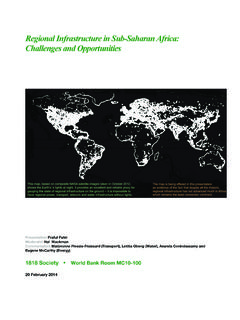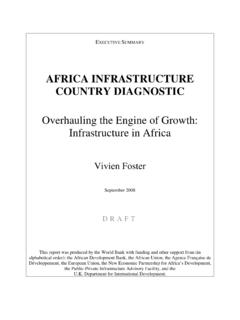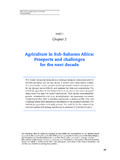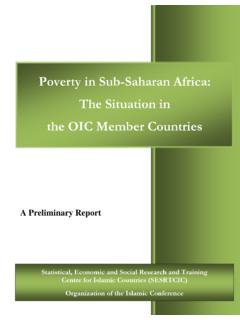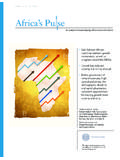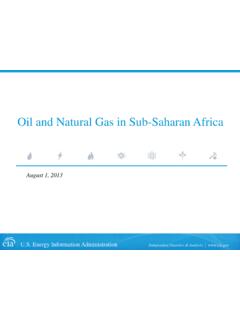Transcription of FINANCING AFRICA’S INFRASTRUCTURE DEVELOPMENT
1 1 FINANCING africa S INFRASTRUCTURE DEVELOPMENT Policy Brief 2015 INTRODUCTION africa has enjoyed significant social and economic progress over the past 15 years, with an average GDP growth rate estimated at in 20151. Yet, this progress has not resulted in commensurate job creation or meaningful economic transformation. INFRASTRUCTURE deficit, hard and soft, has been undermining all the efforts towards achieving sustainable DEVELOPMENT and structural transformation in africa , particularly in view of a rapidly growing population. Indeed, the emergence of a large middle class estimated at nearly 350 million in 2010 is driving the demand for socio-economic INFRASTRUCTURE including access to water and sanitation. Further, structural transformation and industrialization require adequate INFRASTRUCTURE to power economic activity, fuel industrialization, connect producers to markets, enhance intra-African trade and foster regional integration.
2 Projections2 show that: 1. Power demand in africa will rise from 125 gigawatts (GW) required in 2010 to 700 GW by 2040; 2. Transportation volumes on the continent will increase by up to 6-8 times and even higher for landlocked countries; 3. Port throughput is projected to rise from 265 million tonnes in 2009 to 2 billion tonnes in 2040; 4. Water pressure will increase, endangering Nile, Niger, Orange and Volta basins; and 5. Demand for ICT will multiply by 20 by 2020 and data 1 African Economic Outlook 2015 2 E/ECA/COE/31/17 - AU/CAMEF/EXP/17(VII), FINANCING the Programme for INFRASTRUCTURE DEVELOPMENT in africa . needs will surge from the 2009, 300 gigabits per second to 6000 gigabits per second in 2018. africa s INFRASTRUCTURE has been lagging behind others in developing world. Approximately 60% of the continent s population lacks access to modern INFRASTRUCTURE , which isolates communities, prevents access to health care, education and jobs, and impedes economic growth.
3 Only 38% of the continent s population has access to electricity and there is less than 10% internet penetration rate. In addition, 75% of africa s road network is unpaved and poor port facilities add 30-40% to intra African trading costs and FDI. According to the World Economic Forum s Global Competitive Index (GCI) 2014-15, more than half of the 20 least competitive countries in the world are found in sub-Saharan africa , due, in large part, to the region s deep INFRASTRUCTURE deficit. africa s INFRASTRUCTURE services cost more than almost any place in the world, according to the INFRASTRUCTURE Consortium for africa . For instance, African rural population pay around 60 to 80 times per unit more for her energy than urban population in the developed world. Freight costs in africa per tonne are USD to USD compared to USD to USD per tonne in developed countries, making African markets less competitive on the international level.
4 The situation worsens for the 16 African Landlocked Developed Countries where trading costs are 50 times higher than in African coastal countries. Bridging the INFRASTRUCTURE deficit imposes itself with urgency to provide well-functioning regional and national INFRASTRUCTURE , including roads, railways and ports, information and communication technology, 2 energy facilities and health facilities, and the management of water. Accordingly, African leaders have made INFRASTRUCTURE DEVELOPMENT a pillar of the DEVELOPMENT strategy of the continent which is anchored on regional integration and the realization of the African Economic Community enshrined in the 1991 Abuja Treaty. More recently, several blueprints and initiatives emphasized the importance of INFRASTRUCTURE for the continental transformation, as captured with the launch of the New Partnership for africa s DEVELOPMENT in 2001, the adoption of the integrated strategic blueprint for continental INFRASTRUCTURE transformation for 2012-2040, also known as the Programme for INFRASTRUCTURE DEVELOPMENT in africa (PIDA) in 2012, and the adoption of the African Union Agenda 2063 and its first ten year implementation plan in 2015.
5 Agenda 2063 envisions the DEVELOPMENT of world class, integrative INFRASTRUCTURE to support africa s accelerated integration and growth, technological transformation, trade and DEVELOPMENT through the implementation of PIDA. PIDA envisages the DEVELOPMENT of 37,200km of highways, 30,200km of railways and 16,500km of interconnected power lines by 2040. It also plans to add 54,150 megawatt of hydroelectric power generation capacity and an extra billion tons throughput capacity at the ports. This INFRASTRUCTURE will be a catalyst for job creation, manufacturing, skills DEVELOPMENT , technology, research and DEVELOPMENT , integration and intra-African trade, investments and tourism. Intra-African trade is expected to reach 50% by 2045, and africa s share of global trade to increase to 12% by 2063.
6 To drive the implementation of PIDA, African leaders have established the Institutional Architecture for INFRASTRUCTURE DEVELOPMENT in africa (IAIDA) which strengthens coordination among Member States, Regional Economic Communities and key stakeholders. FINANC ING GAPS africa s INFRASTRUCTURE DEVELOPMENT requires significant FINANCING as well as strengthening of the international funding and delivery architecture. According to a study by the World Bank of 2009, the continent needed USD 93 billion per year to fill the INFRASTRUCTURE deficit. For instance, africa s power sector alone is experiencing a finance shortfall of USD 40-45 billion every year since achieving universal access to electricity in africa requires investment of about USD 55 billion per year until 2030. Further, the cost of implementation PIDA requires approximately USD billion annually until 2020 for the 51 projects included in the Priority Action Plan.
7 The implementation of the remaining projects will require an additional USD 300 billion through 2040. According to the NEPAD Agency, the funding gap stood at USD 31 billion per year which includes 75% of capital investment and 25% of maintenance expenditures. Table 1: The cost of implementing the PIDA Priority Action Plan by sector SECTOR NO. OF PROJECTS COST ( USD BILLION) Transport 24 Energy 15 Transboundary Water Resources(TWR) 9 ICT 3 Total 51 Table 2: The cost of implementing the PIDA Priority Action Plan by region REGION NO. OF PROJECTS COST ( USD BILLION) Continental 7 North africa 2 West africa 16 Central africa 9 Southern africa 6 East africa 11 Total 51 Source: FINANCING of the Programme for INFRASTRUCTURE DEVELOPMENT in africa (PIDA) 3 While international aid has helped in meeting some of africa s INFRASTRUCTURE need, it has proven to be insufficient and unsustainable.
8 As such, there is need for an unprecedented mobilization of africa s domestic financial resources and innovative FINANCING . According to a report by the NEPAD Agency and the Economic Commission for africa (ECA) on Mobilizing Domestic Financial for Implementing NEPAD National and Regional Programmes and projects africa looks within , africa could effectively fund up to 70% of its projects through domestic resources. For instance the africa Progress Panel noted that building credible tax systems in African countries could help redirect about USD 21 billion spent on subsidies to wasteful utilities and kerosene to productive energy investment. FINANC ING RESOURCES FO R IN FRASTRU CTU RE In 2014, USD billion was committed to INFRASTRUCTURE FINANCING in africa , according to the INFRASTRUCTURE Consortium for africa .
9 African national governments committed USD billion and the private sector USD billion. africa cannot successfully mobilize resources without the key role of functioning and effective governments. African governments are responsible for creating conducive environments for investment and for creating private sector friendly policies. An enabling environment for public and private sector engagement involves strong institutions to implement the rule of law, transparency and space for political participation. Governments are also key for the DEVELOPMENT of a skilled labour force. Although the private sector in africa remains small compared to other regions, africa should leverage private sector investment through Public-Private Partnerships (PPPs). Research shows that the private equity market in africa is worth USD 30 billion and in 2011 private equity firms in africa raised USD billion in africa .
10 There is rapid growth in African bond markets as the private sector increasingly invests in government debt instruments such as treasury bills and treasury bonds. Furthermore, banking revenues in africa , which are estimated at USD 60 billion, also present strong liquidity and capacity for lending. To bridge the gap, the study by ECA and NEPAD Agency identifies potential sources of finances which include more than USD 520 billion raised annually from domestic taxes in africa ; revenues of about USD 168 billion annually from minerals and mineral fuels; USD 400 billion in international reserves in respective Central/Reserve Banks. In addition, the Stock Market capitalization offers great potentials in view of the increase from USD 300 billion in 1996 to USD trillion in 2007. Table 3: Domestic Financial Resource Potential in africa Tax Revenue: USD 520bn Rapidly Growing Pension Assets Mineral Earnings: USD 168bn International Reserves: USD 400bn Diaspora Remittances: USD 40bn Diaspora Excess Remittances Costs: USD Remittances Securitisation Potential: USD 5-10bn Stock Market Capitalisation: USD (2007) Private Equity Market: USD 30bn Private Equity Market: USD 30bn Bank Revenues: USD 60bn, etc.










